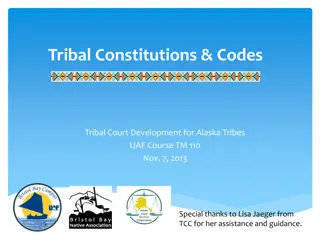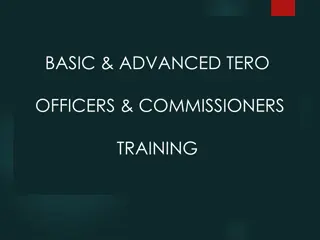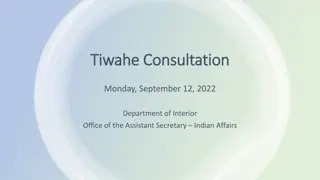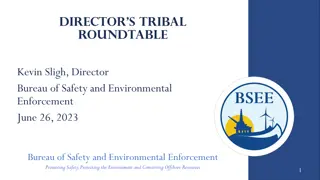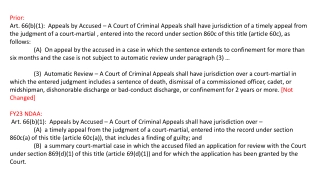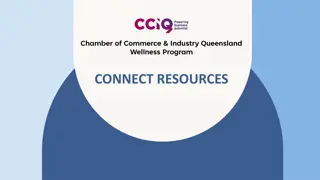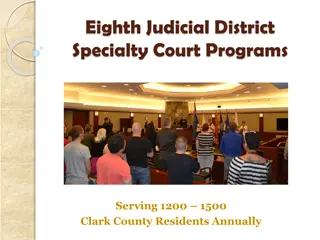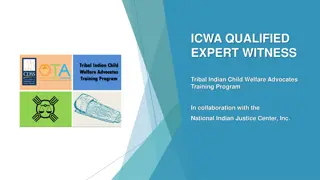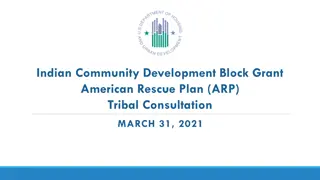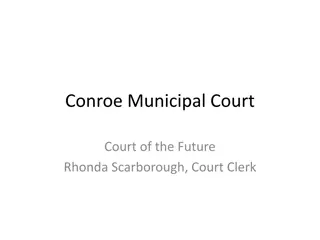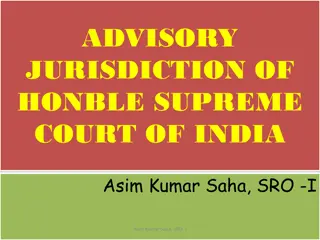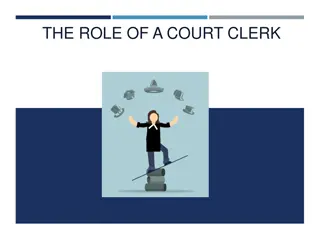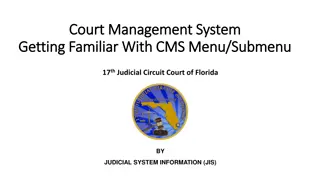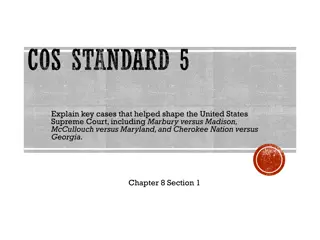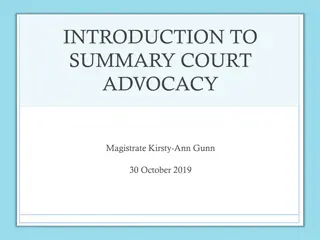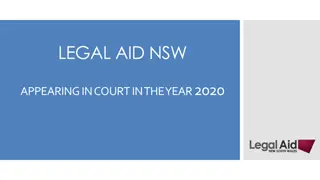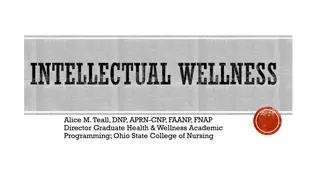Tribal Wellness Court Key Components and Tips
The Tribal Wellness Court emphasizes Community Involvement, Family Relationships, Culture, and Exercise of Tribal Sovereignty. Key components include Individual and Healing Focus, Screening and Eligibility, and Referral Points. Tips focus on Advisory Board involvement, Legal and Clinical Eligibility Criteria, and improving collaboration within the tribe. These components aim to promote healing, Nation Building, and the well-being of the community through a team approach.
Download Presentation

Please find below an Image/Link to download the presentation.
The content on the website is provided AS IS for your information and personal use only. It may not be sold, licensed, or shared on other websites without obtaining consent from the author. Download presentation by click this link. If you encounter any issues during the download, it is possible that the publisher has removed the file from their server.
E N D
Presentation Transcript
Tribal Key Components Tribal Key Components recognize: Community involvement Family relationships and involvement Culture and Tradition Exercise of Tribal Sovereignty www.WellnessCourts.org
Sustained Team, Community, & Nation Building Team, Community, & Nation Building Enduring Knowledge & Experience Eligibility Healing to Wellness Court 10 Key Components Entry Keeping and Telling Stories Healing and Treatment Respectful Communication Discipline & Encouragement Support & Supervision
Key Component #1: Individual and Healing Focus Through Nation Building Brings together treatment, healing resources, and the tribal justice process by using a team approach to achieve the healing of the participant and to promote Native nation building and the well-being of the community.
Tips for Key Component #1 Advisory Board/Steering Committee: Elders Other programs such as housing, social services Cultural partners Improved Collaboration: MOU/MOAs Within tribe With county and state agencies
Key #3: Screening and Eligibility Eligible court-involved substance-abusing candidates are identified early through legal and clinical screening for eligibility and are promptly placed into the Wellness Court. Screening Assessments
Tips for Key Component #3 Legal and Clinical Eligibility Criteria Formalize criteria in Policies and Procedures Manual Applied uniformly Universal Screening Applied to ALL individuals coming into the tribal justice system to avoid falling through the cracks Screening Tool Tools should be standardized, scientifically sound, and appropriate for the population served. Training for staff administering and reading results Assessment Process Completed for every person accepted into HTWC to validate substance abuse/dependence diagnoses
Key #2: Referral Points and Legal Process Participants enter Wellness Court through various referral points and legal processes that promote tribal sovereignty and the participant s due (fair) process rights. Pre/Post Disposition Diversion Transfer from another jurisdiction Civil Dependency Case Pre- or Post- Court Involvement Eligibility
Tips for Key Component #2 Common Entry Points Pre-disposition: After arrest, before criminal charges are filed. Post-plea: Case has been adjudicated; Plea agreement has been negotiated. Post-disposition: Found guilty. Judge may order sentencing. Transfer: from another tribal, state, or county jurisdiction. MOA/MOUs in place. Common Referral Sources Tribal Court County/State Court Peacemaking Program Social Services Self referral Probation
Tips for Key Component #2 Participants must know what to expect from the program Participant handbook Orientation Contract If it s not in the handbook, use caution when proceeding.
Key #4: Treatment and Rehabilitation Wellness Court provides access to holistic, structured, and phased alcohol and drug abuse treatment and rehabilitation services that incorporate culture and tradition. Cultural/Pro- Social Involvement Phases/Behavior Milestones Evidence-Based Interventions
Tips for Key Component #4 Phases Structure Phases so as not to overwhelm the participant in the early stages Over programming can have negative effects Pro-social activities are important Treatment Manualized treatment Treatment Plan Developed Authentic and intentional use of culture and tradition in programming and treatment services
Key #5: Intensive Supervision Participants are monitored through intensive supervision that includes frequent and random drug testing, while participants and their families benefit from effective team-based case management. Case Supervision Drug Testing Management
Tips for Key Component #5 Supervision Probation officers Law Enforcement Case Plans Individualized Trauma-informed care is essential Drug Testing Random Observed Frequent
Key #6: Responding to Participant Behavior Progressive incentives and sanctions are used to encourage participant compliance with Wellness Court requirements. Therapeutic adjustments are made to meet the clinical needs of participants. Incentives, Sanctions &Therapeutic Adjustments Phases
Tips for Key Component #6 Incentives and sanctions must be goal-oriented and individualized. Procedures should be consistent, immediate, and fair. Be creative and go beyond lists of possible incentives detailed in policy and procedure manual Determine the Most Valued Privilege for each participant and incorporate into individualized incentives/sanction protocol Sanctions with little impact are not likely to change behavior (community service, essays, etc) Detention is LAST RESORT Strive to meet a 4-to-1 ratio: 4 incentives to every 1 sanction
Therapeutic Adjustments Should come from the treatment provider GIVE (ENHANCEMENTS) TAKE (REDUCTIONS) New assessment Move from Intensive Outpatient to outpatient Trauma Group Fewer Treatment Groups More Treatment Groups Replacing treatment groups with pro-social activities Move from Intensive Outpatient to Residential Treatment
Key #7: Judicial Interaction The Wellness Court Judge should have ongoing involvement with the team and with each participant.
Tips for Key Component #7 Ongoing judicial supervision communicates to participants, often for the first time, that someone in authority cares about them and is closely watching what they do. Judicial training Judicial interaction with participants should encourage good behavior while discouraging and penalizing inappropriate behavior.
Key #8: Monitoring and Evaluation Process measurement, performance measurement, and evaluation are tools used to monitor and evaluate the achievement of program goals, identify needed improvements, determined participant progress, and provide information to outside agencies.
Tips for Key Component #8 Start with defining what success means to the program and to the participant. Collect and store information electronically for ease of data analysis and report development Review data collected on a regular basis Disseminate summary of data collected to key stakeholders. This helps to let others know the impact the HTWC is making in the community.
Key #9: Continuing Interdisciplinary and Community Education Attend annual trainings on: Substance abuse and mental health treatment Complementary treatment and social services Behavior modification Drug and alcohol testing Team decision making Continuing interdisciplinary and community education promote effective planning, implementation, and operation.
Tips for Key Component #9 Training for HTWC Practitioners Wellness Court Enhancement Training NADCP National Conference National Council of Juvenile and Family Court Judges (NCJFCJ) Treatment Courts Online Learning Platform Treatmentcourts.org
Key #10: Team Interaction The Wellness Court should continue to develop and maintain ongoing commitments, communication, coordination, and cooperation among team members, service providers, and the community.
Tips for Key Component #10 Early determination regarding confidentiality. Rules set in place in Policies and Procedures. Communication between all levels of care must be well- coordinated and flow smoothly. Regular team staffing with consistent attendance of all team members.


